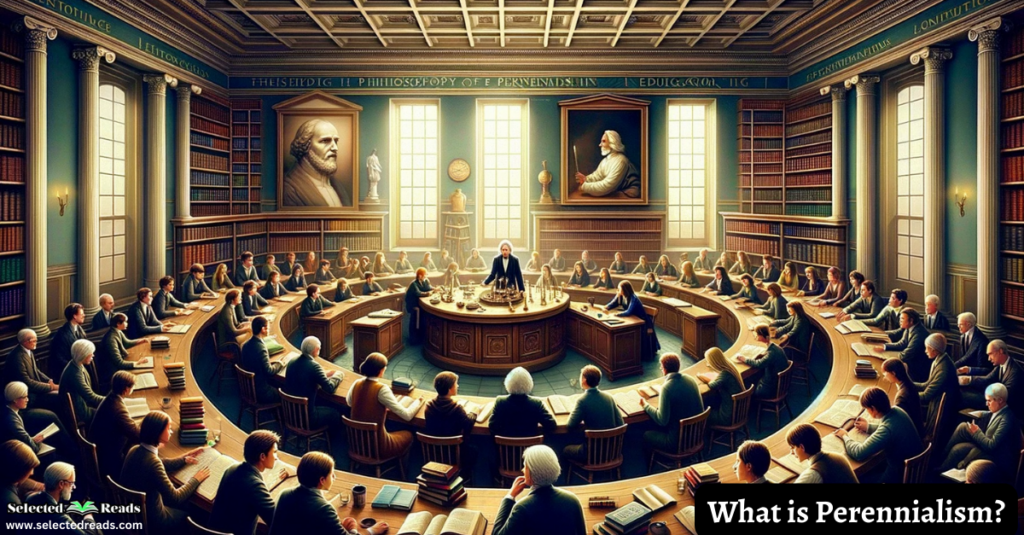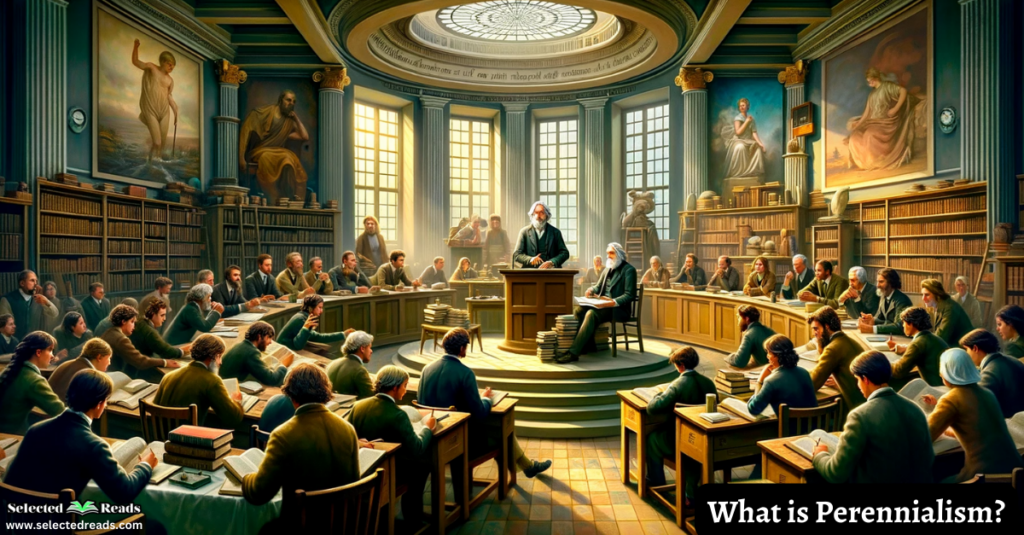Education is a field that is in constant flux. It is continuously expanding as new theories and concepts are being introduced into the literature. Among the numerous theories and philosophies that have shaped the educational field, perennialism holds a unique and timeless place. In today’s post, I take you on a journey through the world of perennialism, explain what it is all about, and talk about its principles and applications in education.
What is Perennialism?
Perennialism in education is a timeless approach, anchoring itself in the belief that certain knowledge and ideas are enduringly valuable, regardless of the era. This philosophy centers around subjects, not just for their content, but for their power to cultivate critical thinking and rational analysis. In the perennialist’ s view, the classroom is a structured, disciplined space, designed to encourage a lifelong pursuit of truth.
At the heart of this approach is a deep reverence for the great works of history’s most profound thinkers. These works, perennialists argue, hold perennial wisdom that remains relevant across ages. The aim is to not just expose students to these timeless ideas, but to guide them in understanding and valuing them. It’s about engaging with these texts in a way that sharpens the mind and fosters an appreciation for enduring truths.
Importantly, perennialism stresses the sequential development of skills. It’s a step-by-step journey toward mastery, where each skill builds upon the last. And in this educational narrative, the teacher plays a pivotal role.
They’re not just facilitators; they’re the guides leading students through this carefully curated intellectual landscape. This mirrors the old saying, “the more things change, the more they stay the same.” In a world of constant flux, perennialism finds a stable ground in the enduring value of great ideas and rigorous thought processes.
Historical Roots of Perennialism
Perennialism has deep roots that can be traced back to the ancient civilizations of Greece and Rome. Its principles and concepts have been influenced significantly by some of the greatest minds in the history of philosophy.
One of the earliest proponents of perennial ideas was the Greek philosopher Plato. His theory of “forms” suggested that there are unchanging, eternal truths or “ideals” that exist beyond our tangible world. This perspective aligns closely with Perennialism’ s emphasis on universal truths and knowledge. Plato’s influence extended to the concept of an ideal (platonic) society, the role of education in its formation, and the importance of moral and intellectual virtues.
Aristotle, a student of Plato, further developed this philosophy, arguing that knowledge is found in universal principles. His belief in the value of logic, reason, and empirical observation greatly shaped the Perennialist perspective.
The philosophy was later revived during the Middle Ages, with the establishment of universities that focused on liberal arts education, teaching canonical texts that were considered the foundation of Western thought.
Fast-forward to the 20th century, Perennialism found its voice in American education through Robert Maynard Hutchins and Mortimer Adler. Hutchins, a University of Chicago president, and Adler, a philosopher and educator, promoted the idea of the “Great Books” curriculum, which included classical texts from Western literature, philosophy, and science.
Their efforts culminated in the creation of the “Great Books of the Western World” series, which is considered a comprehensive compendium of the most important works of Western civilization. This further institutionalized Perennialism, framing the philosophy as a core aspect of educational curriculum and pedagogy.
These historic forerunners of Perennialism incorporated this philosophy into early educational systems, underpinning curricula with classical texts and moral instruction. The goal was to shape not only knowledgeable but also virtuous citizens who could contribute effectively to their societies.
Even today, the influence of Perennialism is evident in many schools and universities that strive to provide students with a broad, foundational education grounded in critical thinking, ethical values, and a shared cultural heritage. The study of classic literature, philosophy, mathematics, and sciences—central to Perennialist thought—remains a staple of many educational institutions around the world.
Key Principles of Perennialism
Perennialism, a subject-centered philosophy, is built on several central principles that define its perspective on education and knowledge. These principles create a distinctive framework that guides the learning process and informs the content of a perennialist curriculum.
- The Enduring Nature of Truth: Perennialists believe that certain truths are constant and unchanging, regardless of time, place, or culture. These truths are considered universal and are typically found in the realms of philosophy, mathematics, logic, and morality. This belief steers the perennialist educational approach towards the exploration of these universal truths, and away from transient information or vocational skills.
- The Importance of Rational Thought: Reason is highly valued within perennialism. The ability to think logically and critically is considered an essential tool for uncovering and understanding the enduring truths of existence. As such, perennialist education often involves rigorous intellectual training to develop students’ reasoning abilities.
- Focus on Classical Texts: Often referred to as the “Great Books” approach, perennialists contend that the most profound truths are articulated in the classical literature and philosophical works of Western civilization. They believe that engaging with these texts allows students to grapple with fundamental questions about human existence, morality, and the nature of the universe, fostering a deeper understanding of the human condition.
- Consistent, Universal Nature of Knowledge: Perennialists view knowledge as a cohesive whole, not as a collection of disconnected facts. They believe in a structured and systematic approach to learning, where each subject is interconnected. As such, they encourage students to explore the relationships and connections between different areas of knowledge.
- Moral and Ethical Education: Perennialists emphasize the development of moral character and ethical understanding. They argue that education should involve the cultivation of virtues and the study of moral principles, often through the analysis of ethical dilemmas presented in classical texts.
These principles collectively form the core of perennialism. They shape a specific approach to education, one that is focused on intellectual rigor, moral growth, and engagement with enduring ideas. This philosophy, while perhaps not fully embraced in its entirety by every modern educational institution, has nonetheless significantly influenced our understanding of the educational process.
Perennialism in the Classroom
The principles of perennialism shape a distinctive environment in the classroom. Here’s a look at what a perennialist classroom might entail:
- Teacher-Led Discussions: A perennialist classroom often centers around teacher-led discussions. These discussions are not just lectures; rather, they are opportunities for students to engage with the material, ask questions, and express their thoughts. Teachers play the role of guides, leading students to contemplate profound ideas and truths through thought-provoking questions.
- Critical Analysis of Texts: Perennialist education places a heavy emphasis on the study of classic texts, whether they are works of literature, philosophical treatises, or historical documents. These texts are not merely read but are analyzed in-depth. Students are encouraged to interpret the text, draw connections to universal truths, and critique the ideas presented, all while developing their critical thinking skills.
- Emphasis on Intellectual Development: Intellectual growth is the cornerstone of perennialist education. This philosophy aims to cultivate students’ reasoning abilities, foster their understanding of enduring truths, and encourage their exploration of moral and ethical questions. This goal is often achieved through rigorous academic study, Socratic dialogue, and moral instruction.
- Role of the Teacher and Students: In a perennialist classroom, the teacher is viewed as a knowledgeable guide who facilitates students’ engagement with enduring ideas and universal truths. They are not just transmitters of information, but cultivators of wisdom and virtue. They ask probing questions, encourage intellectual curiosity, and guide students in their exploration of challenging material. On the other hand, students are active learners in this setting. They are not passive recipients of knowledge but engaged participants in the learning process. They are encouraged to question, discuss, and reflect upon the ideas presented to them. Their role is to seek understanding, develop their intellect, and strive towards the attainment of wisdom.
The perennialist classroom, therefore, is a space of intellectual engagement, moral contemplation, and personal growth. It encourages both teachers and students to dive deep into the pool of enduring knowledge and emerge with a greater understanding of the world and their place in it.
Criticisms of Perennialism
Like all educational philosophies, Perennialism has its weak points. Here’s a look at some of the key criticisms associated with Perennialism:
- Lack of Consideration for Individual Interests: Critics argue that Perennialism’s focus on a fixed set of knowledge can neglect students’ individual interests, talents, and cultural backgrounds. This may lead to disengagement or a lack of relevance for students who do not see themselves or their interests reflected in the curriculum.
- Potential for Rigidity: The Perennialist emphasis on enduring truths and classical texts can be seen as rigid or inflexible. Critics suggest that this approach may not adequately prepare students for a rapidly changing world, as it may not incorporate current scientific advancements, contemporary issues, or future-oriented skills.
- Limited Cultural Perspective: Perennialism traditionally leans heavily on Western texts and ideas, which critics argue could lead to a Eurocentric bias in the curriculum. This approach might exclude other cultural perspectives and contributions, limiting students’ understanding of a diverse and interconnected world.
Conclusion
In closing, perennialism stands as a significant educational philosophy with its emphasis on enduring truths, critical thinking, and the study of classical texts. Rooted in centuries-old wisdom and brought to life by influential philosophers and educators, it serves as a testament to the timeless nature of certain aspects of human knowledge and understanding.
While it has its critics, particularly those who see its approach as inflexible or neglectful of individual interests and contemporary relevance, its strengths cannot be dismissed. The focus on the development of intellectual rigor, moral character, and an appreciation for our cultural heritage continues to have value in our rapidly evolving world.
As with any educational philosophy, Perennialism serves as a guide rather than an immutable blueprint. It provides a perspective that can inform an educator’s approach to teaching and learning, even if it doesn’t dictate every aspect of classroom practice.
Whether educators lean towards Perennialism or not, reflecting on its principles can help deepen their understanding of their educational values and goals. The timeless questions and issues that Perennialism raises continue to be relevant as we contemplate the purpose of education and how best to prepare students for their future while helping them appreciate the wisdom of the past.
References:
- Schools of Educational Philosophy, Chapter 9: What are the philosophical foundations of American Education. Retrieved from https://ctei.jhu.edu/files_ta/4_Major_Educational_Philosophies.pdf
- Perennial Philosophy, Wikipedia, https://en.wikipedia.org/wiki/Perennial_philosophy
- Robert Maynard Hutchins, Britannica, https://www.britannica.com/biography/Robert-Maynard-Hutchins
- Mortimer J. Adler, Britanica, https://www.britannica.com/biography/Mortimer-J-Adler
- Great Books of the Western World, Britannica, https://www.britannica.com/topic/Great-Books-of-the-Western-World
- Perennialism in Education, by Dr. V.K. Maheshwari, http://www.vkmaheshwari.com/WP/?p=166
Further readings
- Adler, Mortimer, In Defense of the Philosophy of Education,” Philosophies of Education. National Society for the Study of Education, Forty-First yearbook, Part I. Chicago: University of Chicago Press, 1942.
- Blum, J. (2017). Comparison and the Spectre of Perennialism: A Reply to Craig Martin. Method & Theory in the Study of Religion, 29(4–5), 340–346. https://www.jstor.org/stable/26507455
- Brameld, Theodore, Philosophies of Education in Cultural Perspective. New York: Dryden Press, 1956.
- Butler, J.Donald, Four Philosophies and Their Practice in Education and Religion. New York: Harper & Row, Publishers, 1957.
- Cotter, A.C. ABC of Scholastic Philosophy. Weston, Massachusetts: Weston College Press, 1949
- Dible, R. T. (2010). The Philosophy of Mysticism: Perennialism and Constructivism. Journal of Consciousness Exploration & Research, 1(2), 173–183.
- Ferrer, J. N. (2000). The Perennial Philosophy Revisited. Journal of Transpersonal Psychology, 32(1), 7–30.
- Forman, R. K. C. (1999). Mysticism, mind, consciousness. State University of New York Press.
- Jones, R. H. (2022). Perennial Philosophy and the History of Mysticism. Sophia, 61, 659–678. https://doi.org/10.1007/s11841-021-00847-3
- Martin, C. (2017). “Yes, … but …”: The Neo-Perennialists. Method & Theory in the Study of Religion, 29(4–5), 313–326. https://www.jstor.org/stable/26507452
- Oldmeadow, H. (2007). The comparative study of eastern and western metaphysics: A perennialist perspective. Sophia, 46(1), 49–64.
- Smith, H. (1987). Is there a perennial philosophy? Journal of the American Academy of Religion, 55, 553–566.
- Taylor, S. (2023). A New Day for Perennialism: the Case for a Perennial Phenomenology, or ‘Soft’ Perennialism. Sophia. https://doi.org/10.1007/s11841-023-00985-w








